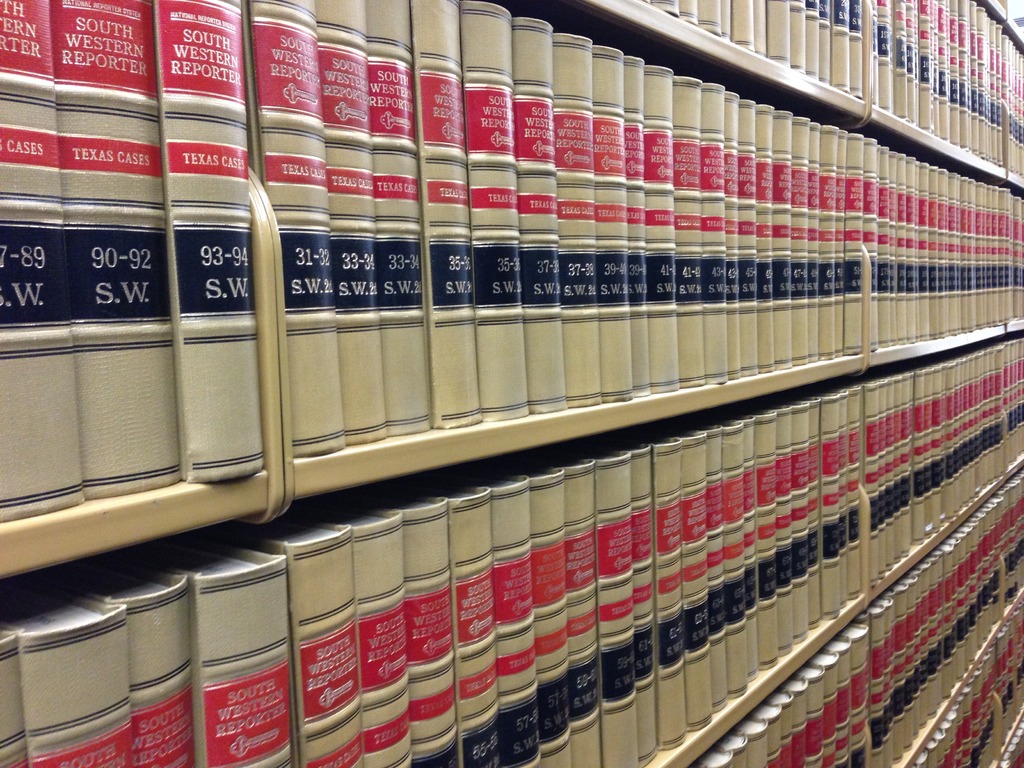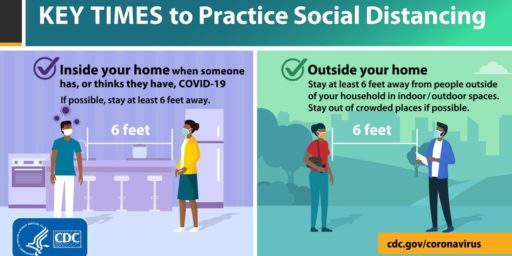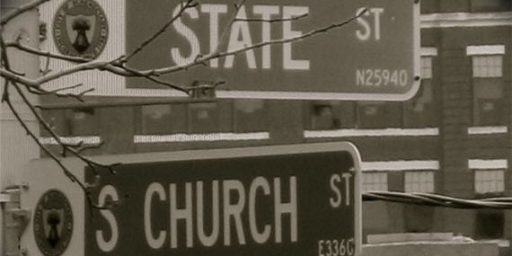SCOTUS Lifts California Worship Ban
How should we balance public health and fundamental rights?

POLITICO (“Supreme Court lifts California worship bans prompted by coronavirus“):
A splintered U.S. Supreme Court blocked California from enforcing coronavirus-related bans on indoor worship services, but declined to upset other state rules banning singing and chanting and limiting the number of worshipers.
The ruling issued just before 11 p.m. ET Friday produced four separate statements by the justices, as well as a convoluted description of what relief various justices would have granted to churches objecting to the limits.
However, a majority of the court was only willing to lift the ban California has applied on all indoor worship in Tier 1 counties — those most challenged by Covid-19. The other restrictions remain undisturbed, for now.
Perhaps the most surprising aspect of the Friday night ruling: new Justice Amy Coney Barrett, whose conservative Catholic views drew suspicion from many liberals in advance of her confirmation last year, declined to grant the churches the most sweeping relief favored by her most conservative colleagues.
Justices Neil Gorsuch and Clarence Thomas would have granted all the churches’ requests, lifting the singing and chanting bans and barred California from enforcing a 25 percent capacity limit that applies to many indoor facilities. Justice Samuel Alito would have had such a ban kick in 30 days from now if the state didn’t make certain showings in court.
“Even if a full congregation singing hymns is too risky, California does not explain why even a single masked cantor cannot lead worship behind a mask and a plexiglass shield. Or why even a lone muezzin may not sing the call to prayer from a remote location inside a mosque as worshippers file in,” Gorsuch wrote.
Barrett opted for a middle-ground position with Justice Brett Kavanaugh that did not go as far as Gorsuch, Thomas or Alito.
“The applicants bore the burden of establishing their entitlement to relief from the singing ban. In my view, they did not carry that burden—at least not on this record,” she wrote in a brief opinion.
The court’s three liberals dissented from the decision, arguing that the court was unwise to substitute its judgment for that of state officials amid the ongoing pandemic.
“Under the Court’s injunction, the State must instead treat worship services like secular activities that pose a much lesser danger. That mandate defies our caselaw, exceeds our judicial role, and risks worsening the pandemic,” Justice Elena Kagan wrote in a dissent joined by Justices Stephen Breyer and Sonia Sotomayor. “In the worst public health crisis in a century, this foray into armchair epidemiology cannot end well.”
Kagan also suggested that given California’s climate, a ban on indoor worship is less onerous there than elsewhere. “Given California’s mild climate, that restriction—the one the Court today lifts for houses of worship alone—does not amount to a ban on the activity,” she wrote.
Chief Justice John Roberts, who provided a swing vote last year leading to rulings turning down churches’ requests for relief from virus-related limits, said he still believes in deference to elected officials. But he said Friday the outright ban in place in much of California defied logic.
“The State’s present determination—that the maximum number of adherents who can safely worship in the most cavernous cathedral is zero—appears to reflect not expertise or discretion, but instead insufficient appreciation or consideration of the interests at stake,” Roberts wrote. “Deference, though broad, has its limits.”
I haven’t had time to dive into the particulars of the various requests to assess their merits. I therefore have no opinion as to whether the more maximal or minimal grants were appropriate.
That said, my thinking on these cases has evolved. While I have sided with Kagan’s premise—that it’s appropriate to treat worship like secular activities—I’m coming to believe that’s incorrect. Rather, the Constitution requires that the exercise of religion be granted exceptional deference just as we do for other First Amendment freedoms, including protest.
Probably because I’m not religious, I have tended to regard in-person religious services as something akin going to the movies or out to a restaurant. That is, as a purely optional social activity that governments can reasonably regulate to prevent negative externalities. One suspects Governor Newsome and other high-level California decisionmakers were taking the same view.
But, of course, neither theaters nor restaurants, institutions with which the Framers would certainly have been familiar, are specifically enshrined in the Bill of Rights. Yet the very first provision protects establishments of religion, the free exercise thereof, speech, the press, peaceable assembly, and the right to petition the government for a redress of grievances.
For both practical and philosophical reasons, neither the Federal, state, or local governments tried to enforce masking, social distancing, or crowd size limitations during the Black Lives Matter protests. They rightly viewed them as in a different category than spectator sports, concerts, or even funerals.
By analogy, we should view religious services differently than block parties, sports bars, and barbecues. Rather than mere social activities, they’re fundamental to worship and therefore essential for believers.
If we start from that premise, it doesn’t end the discussion. Governments have the right to place time, place, and manner restrictions on speech and assembly to balance against other needs of the community. And, certainly, preventing the spread of infectious disease is a very strong and legitimate interest.
It does, however, mean that we should treat church services as essential services rather than as entertainment. Under that premise, it would be hard to justify banning all indoor worship while allowing grocery shopping and visits to the liquor store.






No, no it isn’t. Even granting the premise that worshipping in an indoor building is essential under religious laws/beliefs (which it isn’t*), you can’t equate sitting in a confined space for an hour (or 3) with a short-duration activity involving moving around.
_________
* honestly, from a religious perspective I find these churches perspectives grotesque and contrary to theology. If your religious beliefs require risking human lives and safety, you have strayed. These seem more like political or ideological beliefs than religious ones.
I understand your thinking but this is a poor analogy, unless your ABC store has all the customers lining up shoulder-to-shoulder singing the praises of Buffalo Trace.
But church services, and all that goes with them, are fundamentally more like the kinds of in-person gatherings that have proven to be a primary method of COVID spread. Churchgoers are going to greet each other with handshakes and hugs. Even masked, if they all sing it will spread virus, and I guarantee they won’t all keep their masks on. We know how this goes because we’ve seen how this goes.
Fortunately, the High Court left in place the capacity limitations. One would hope the churches would require–and/or the worshipers voluntarily choose–to keep space between people. But what difference does a 25% capacity maximum make if they all sit in the same row?
Now, if they opened the churches up and offered the vaccine to all in attendance…that I could support.
@SKI:
This is America. OF COURSE this is politics masquerading as religion.
Not mentioned is a prime concern of many congregations, funding. Interacting with family in North Carolina, who are by and large active church participants (way beyond just regular Sunday service attendance), most churches are seeing a significant drop-off in collections and tithes. Very few churches have the wherewithal to have members sign up for automatic debits, they depend on checks or cash mailed, or more often dropped off in person. If the congregation is limited to streaming services, members aren’t entering the sanctuary, so are less likely to “remember” their financial obligations, even if they have funds available. Many if not most will make the effort, but most churches are overbuilt for the size of their congregation, so any diminution of cashflow is significant.
Much easier though to make this an argument about First Amendment rights than about government support of in-efficient industry.
This looks to me like thinking consistent with particular forms of religiosity. By contrast, Judaism specifically teaches that where life and health are affected by religious observance, it’s life and health that get preference.
Than again. if you are a megachurch pastor, it’s a challenge to keep up the private jet payments without butts in pews. Thus, no online services by Zoom for you.
@charon:
This sort of SCOTUS decision is poor public relations for the churches as it promotes cynicism about religion, especially politicized religion.
I went to a funeral for a friend (cancer, not covid) a few weeks back. It was at a large non-denominational megachurch. The sanctuary was large but most packed the seats to the front. Most did not wear masks. Following the service was the receiving line with a lot of hugging and conversation. And the prevailing attitude seeping through the funereal grief was standard issue conservative grievance. It had all the trappings of a superspreader event. Fortunately, that did not happen. That I know of.
These are tough issues and state guidance is broad. Receiving the guidance at the local level is a microdecision. You would want the recipients of the guidance to be rational but it seems to be always emotional. And I find having the SC weigh in on these small matters to be absurd. Which, I think, is why, out of nine justices, you got wide range of responses. Because they were individual emotional responses, not legal ones. Despite the trappings of legalisms.
@SKI:
I don’t think the government gets to decide whether a given religious belief is correct. That’s fundamental to the Establishment Clause.
We’re in agreement on that. But it’s one thing to say that public health demands that churches require masking and social distancing and quite another to simply declare them unessential. Surely, a handful of people separated into household clusters can conduct worship services simultaneously in even a relatively small church. There’s enough room to separate them. But, again, the starting point should be that this is an essential activity and that restrictions must be reasonable in order to balance competing interests.
But what’s next? Carving out an exception in time, place, and manner free speech restrictions for religious speech? As long as religious groups aren’t being specifically targeted and instead fall under the same broad net that is catching secular public gatherings I fail to see an issue here. They can do what the rest of us are doing: Zoom meetings.
COVID makes no religious exemptions, and the people in these superspreader events then go into the community, grocery stores, offices, liquor stores, etc., and keep passing on the virus to others.
As to protests, I would see nothing wrong or unethical in limiting sizes r activities, but how would you go about enforcing such things? Who owns the streets? Who manages membership in a crowd?
I’m game as long as all the people not wanting to socially distance themselves or wear masks are willing to put themselves on a list stating that they are perfectly happy to be at the end of the line when it comes to medical treatment for Covid. Oh, and that they admit liability in case anyone who can prove they have come into contact with them catches Covid as well.
There is nothing to balance. We know what high risk activity is so those activities should be subject to restrictions and only relaxed if mitigation measures are put in place. Of course, the CDC guidelines, would probably have to be translated to make an implementable rule. But something like:
Indoor activities must only allow 6 people for every 144 sqft with masking. 10 may be accommodated with “yadda-yadda” type air filtration and/or exterior air intake. With no mitigation, masked patrons to indoor activities are only allowed to remain inside the facility for no longer than 15 min.
At that point it doesn’t matter if its a church or a brothel. The standard is the standard. This parcing of essential business/activites from non-essential is actually what’s causing the opening for court challenges. Sure, it worked in the first few months when we didn’t understand how people got infected but its not useful anymore. Describe the activities needed to be restricted; allow for mitigations; then move on.
@Jim Brown 32:
Some things are more essential than others, I think it reasonable to differentiate the grocery and the pharmacy from the bookstore and the dress shop. Dresses can be postponed, pharmaceuticals and food not so much.
But there appears to be some disagreement here about whether churches are essential.
Read on Deadline that Hollywood is busy setting up its own religion where worshippers will meet in AMC, Regal, and Cinemark theathers, read some uplifiting qoutes from saints like Walt Disney, then watch a movie for moral and spiritual support while eating some holy popcorn.
Amen!
@James Joyner:
No. But the court could ask if there’s documentation that said belief existed prior to COVID.
The analogy to protests is … strained. I see a lot of commentary lately to the effect that BLM got to riot, why don’t I get to break into the Capitol or whatever. People went into the “BLM” demonstrations knowing they might get beat up, shot with rubber bullets, perhaps with real bullets, and might get arrested and charged. I put BLM in quotes because they’re called BLM protests, but there’s a large element of spontaneity, on top of some organizing by BLM, and many other groups in parallel. It’s not so much that cities decided to allow protests because 1st Amendment as that the protesters were prepared to ignore restraints. Not quite analogous to the church announcing it’ll have services at 9:00 and 11:00 every Sunday and going to court to demand the government let them. I’d feel more sympathy for the sincerity of their beliefs if they held services in defiance of state orders and were willing to go to jail for it.
We require that churches meet building codes. I expect that the fire officials would object if they overcrowded the building. If they park on the street, we require they meet parking regs (albeit they are often granted lax enforcement). Are public health measures so different? Do the rights of non-congregants who may come into contact with the congregants count for nothing?
And would this even be an issue if the then president hadn’t made ignoring COVID a political statement?
@gVOR08:
BLM protests were outdoors, big difference. From the pix I saw mask wearing almost universal – likely due to different political attitude of the people involved.
@charon: I think Jim Brown 32’s point is that “essential” isn’t working as a criterion, so the new solution is set the standard of what’s to be considered “safe” and let the members of society assume their own risk for whatever activities they want/need to do. Shopping for a dress is neither more nor less dangerous than shopping for food, eating a sandwich, getting a prescription filled, watching a movie; why exclude anything?
From what I can tell, only one church in our town is holding live services. They have a congregation of about 30 and a sanctuary that seats about 500. I think they can figure out how to make that work.
Pollito scrawled:
Perhaps, having been the reason for a super spreader even, Amy Coney Barrett is just wary of getting the nickname “Amy Covid Barrett”.
Except entertainment is also protected by the first amendment. If that’s enough to override the restrictions for religious services, why isn’t it enough to override the restrictions for theater, movies, concerts, etc.?
@Jim Brown 32:
Some activities are protected under the constitution, and others are not. Restrictions for those that are are held to a higher standard of legal review — which is undoubtably a good thing.
A one-size fits all “the standard is the standard” approach would need an appeals process specifically for the protected activities, where that higher standard must examined. Religious activities are definitely among the protected activities, whether we secular folks like it or not.
If restrictions were placed on voting because of covid, we would be rightly outraged and demand they be lifted or accommodations made to ensure that everyone can vote. Religious practice has more protections under the constitution than voting does (whether that is morally right or wrong, it’s true — there is no affirmative right to vote).
So legally a single standard would either be hard to implement, or would have so many holes as to be useless everywhere.
Socially it’s just as hard. Making people do something they resent makes them push back and stop complying — and stop complying everywhere, not just in the particular. It’s bad policy.
So, we either need to not restrict them, or make the restrictions something they don’t resent. Having a set of baseline restrictions, and working with the churches to help them mitigate risk and opening up a bit more there as safely as possible is going to cut that resentment — not to nothing, but to less.
Few people resent not being able to go to a movie theater. If the government gets between you and Wonder Woman 1984: Big Sister, it might be annoying, but that’s generally it. But the government getting between you and your sky gods? That’s going to be common.
I don’t see a way to allow the congregation to sing in person. You may be able to mitigate risk for a small choir or a lone muezzin singing the call to prayer. A small choir might lead to people singing along though, so maybe not.
Capacity restrictions can be mitigated with outdoor areas or more services — and it would be entirely appropriate to have a county health employee or such help explain the ways to mitigate, and other officials helping implement the mitigation. And taking those efforts helps people understand that they are being listened to, and it reduces resentment.
We may be reading different first amendments.
@Gustopher:
The first amendment protects religion, the press, speech, assembly, and petition. So either this ruling implies all five deserve exemption from COVID19 restrictions, or it’s arbitrarily pulling one of the five out and saying it gets a higher degree of protection than the other four.
@Stormy Dragon: And where do you see entertainment in that group?
If you squint hard enough, you might see a non-political concert (let’s say a Whitesnake cover band) in:
– “freedom of speech”: We have held that the government can regulate the manner of speech, but political speech gets the highest protection.
– “freedom of assembly”: Note that the clause, marked with semicolons because it is antiquated english, includes the purpose “to petition the Government”, which is broadly interpreted at political speech. Again, much higher protection for protests than Whitesnake cover bands.
– “freedom of association”: not explicitly mentioned, but generally regarded as being there between the lines. That covers the government not being able to break up groups of Whitesnake fans merely for liking Whitesnake, but we can regulate the manner of the association. And again, political associations get much higher protection.
IANAL, but I’m pretty sure there is limited constitutional protection for being able to go see a Whitesnake cover band play at the local bar. State constitutions may provide for greater protections.
This is despite them having such classics as this: https://www.youtube.com/watch?v=JFS-91Qhwdw — who can argue with the profound nature of the lyrics “Lie down, I think I love you. / Lie down, I think I care.”?
Rights are also balanced against other rights, which is why the level of scrutiny becomes important, as this can determine which right gets precedence when they are in conflict. For instance, the Supreme Court ruled that while you have a right to a speedy trial, and you have a right to a public defender, exercising that second right limits the first. (Vermont v. Brillion)
So, restrictions that affect a performances by a Whitesnake cover band can be found acceptable that would not affect a religious service or political event. (The Church of St. John Coltrane is likely to create all sorts of confusing edge cases)
(I happened to be listening to Whitesnake, which is why they are my example of basically apolitical entertainment — in Saudi Arabia, this would be very political, but not here)
Treating houses of worship differently than other areas of public assemblage is not government neutrality which is what the 1st amendment strives for, in fact it is the opposite, it is the actual overt of establishment of religion. It is getting to the point that anyone can create their own religion to avoid any state law, and why not? What is a religion? It is simply a belief system.
@Gustopher:
That’s my point: while freedom of speech protects the Whitesnake cover band’s performance, that doesn’t exempt them from COVID19 restrictions. Freedom of religion protecting the local youth minister’s sermon shouldn’t exempt them from COVID19 restrictions either.
By SCOTUS saying freedom religion does exempt the minister in this ruling, we have to ask whether they’re overturning the precedent for the Whitesnake cover band as well, or are they saying religious expression deserves better protection than non-religious expression under the first amendment.
Either way they go is a really bad precedent.
@Stormy Dragon: There’s no First Amendment right to go to the movies, eat at restaurants, or attend sporting events. Those activities are likely protected under broader liberties but they don’t enjoy particular protection.
You’re all missing the key point. You can see this by applying your argument to the case of Mary Mallon. By any Bill of Rights standard, the government had no right to imprison her, to deny her employment in her chosen profession, etc.
Are you arguing that Typhoid Mary should have been allowed to spread contagion without let or hindrance? If not, you need a new argument.
@James Joyner:
So in your mind, Congress could ban all public exhibition of film and there would be absolutely no first amendment issues with that? (and to be clear, I don’t mean “theaters are closed until the pandemic ends”, I mean Iran style “all movies are decadent and therefore permanently banned”).
@charon: Well certainly some activities are more essential than others–but that’s irrelevant to mitigating risk. Parsing essential activities from non-essential activities in order to ban activities deems ‘non-essential’ is a risk elimination play.
While that seems prudent–there is the irrationally of ‘human factors’ that have to be dealt with. Risk elimination strategies need to employed in only in an emergency. They burns political capital and forces “ban avoidance” behavior that are more risky than what we were trying to fix in the first place.
In order to strike a good balance between public health and economic factors risk mitigation is the way long term. Go buy the dress–but be in and out in less than 30 min.
@Gustopher: Which is why my course of action would be to keep the public health regulations to the certain risk profiles regardless of what service is being rendered inside the building. Churches don’t get to flaunt OSHA standards because they are a church. Sure, if you are talking ban on activities–there has to be sensitivities because of Constitution rights. I not talking about bans because I dont believe they are necessary and have proven to force ‘ban avoidance’ behavior that are riskier than the original problem we were trying to fix. No Church could argue they were being singled out or oppressed when they are being held to mitigate the same risk profile as every other indoor service provider whose operations is similar to theirs.
@Jim Brown 32:
Are you sure?
I know they are exempt from a lot of hiring regulations and laws. I wouldn’t be surprised if they were exempt from some OSHA requirements as well. As a rule of thumb, you have to show a much higher state interest when interfering with a church.
(Google, Google… osha exemption church):
From which I gather the the lack of safety railing in the Death Star would be acceptable if the Death Star were a church, and the narrow ledges over massive drops were restricted to religious services. The Holy Rite of Blowing Up Alderaan, for instance.
@Stormy Dragon:
If the films can be made available streaming, in your home, is there a free speech issue? No. There may be other issues, but not free speech.
@Gustopher: Not entirely sure. You’d think that would be common sense. I do know for certain that they cant weasel out of Americans With Disabilities requirements though. If there are OSHA loopholes…its an example of stupid governance.
@Stormy Dragon:
So long as the restrictions are content-neutral, the government has rather broad powers to regulate commerce in a way they don’t religious expression. But you’ve chosen an example of how it could violate the First Amendment. I can’t imagine the courts allowing closing theaters on the grounds that the content is “decadent.”